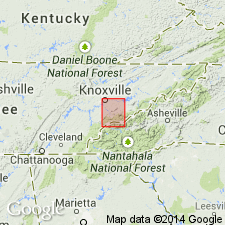
- Usage in publication:
-
- Hesse sandstone*
- Modifications:
-
- Original reference
- Dominant lithology:
-
- Sandstone
- AAPG geologic province:
-
- Appalachian basin
Summary:
Pg. 3. Hesse sandstone [of Chilhowee group]. Fine, white, massive sandstone, formed of round quartz grains. Thickness more than 500 feet. Overlies Murray shale. Underlies Apison shale. [In parts of northeastern Tennessee is overlain by Shady dolomite.] Age is Early Cambrian.
[Named from Hesse Creek near Chilhowee Mountain, Blockhouse quadrangle, Blount Co., eastern TN. Extends into western NC.]
Source: US geologic names lexicons (USGS Bull. 896, p. 948; supplemental information from USGS Bull. 1200, p. 1748).
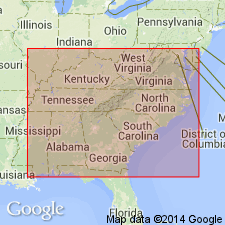
- Usage in publication:
-
- Hesse sandstone†
- Modifications:
-
- Abandoned
- AAPG geologic province:
-
- Appalachian basin
Summary:
Hesse sandstone abandoned; evidently a synonym of Erwin quartzite.
Source: GNU records (USGS DDS-6; Reston GNULEX).
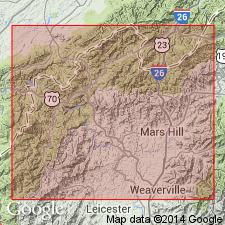
- Usage in publication:
-
- Hesse quartzite
- Modifications:
-
- Revised
- AAPG geologic province:
-
- Appalachian basin
- Piedmont-Blue Ridge province
Summary:
Two sets of formation names for Lower Cambrian clastic rocks are in use in eastern TN and western NC. Northeastern TN names Unicoi, Hampton, and Erwin are used in this report for same rocks Keith (1904) and Stose and Stose (1947) called Cochran, Nebo, Murray, and Hesse, all defined by Keith (1895) in Chilhowee Mountain area, Blount and Sevier Cos., TN. Hot Springs, NC, lies midway between type localities for each group of names. Hampton and Erwin formations, as used in this report, include Hesse quartzite.
Source: GNU records (USGS DDS-6; Reston GNULEX).
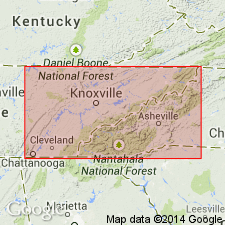
- Usage in publication:
-
- Hesse sandstone*
- Modifications:
-
- Revised
- AAPG geologic province:
-
- Appalachian basin
Summary:
Table shows Helenmode member at top of Hesse sandstone.
Source: GNU records (USGS DDS-6; Reston GNULEX).
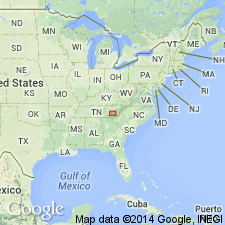
- Usage in publication:
-
- Hesse quartzite*
- Modifications:
-
- Age modified
- AAPG geologic province:
-
- Appalachian basin
Summary:
Chilhowee group as a whole is classed as Cambrian and Precambrian(?). Helenmode formation at top is Cambrian based on fossils; remaining unfossiliferous formations [including Hesse quartzite] are Precambrian(?).
Source: GNU records (USGS DDS-6; Reston GNULEX).
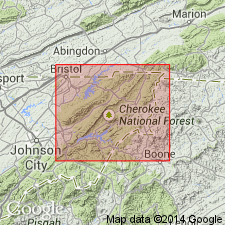
- Usage in publication:
-
- Hesse quartzite member*
- Modifications:
-
- Revised
- Age modified
- AAPG geologic province:
-
- Appalachian basin
- Piedmont-Blue Ridge province
Summary:
In northeasternmost TN and adjacent VA, considered Hesse quartzite member of Erwin formation of Early Cambrian age. Overlies Murray shale member; underlies Helenmode member.
Source: GNU records (USGS DDS-6; Reston GNULEX).
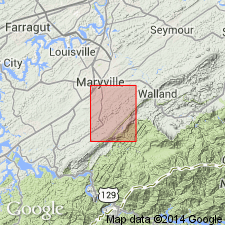
- Usage in publication:
-
- Hesse quartzite*
- Modifications:
-
- Age modified
- Revised
- AAPG geologic province:
-
- Appalachian basin
Summary:
Age of Hesse quartzite is Lower Cambrian(?). Overlies Murray shale; underlies Helenmode formation.
Source: GNU records (USGS DDS-6; Reston GNULEX).
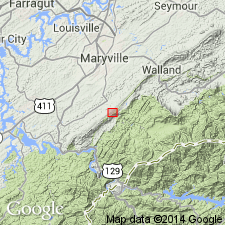
- Usage in publication:
-
- Hesse Quartzite*
- Modifications:
-
- Age modified
- AAPG geologic province:
-
- Appalachian basin
Summary:
Ostracode INDIANA TENNESSEENSIS (Resser) found in lower part of Murray Shale on Chilhowee Mountain confirms Early Cambrian age for Murray Shale and overlying Hesse Quartzite. Previous age was Early Cambrian(?) because of uncertainty of location of site and stratigraphic position of collections reported by Walcott (1890) and Keith (1895).
Source: GNU records (USGS DDS-6; Reston GNULEX).
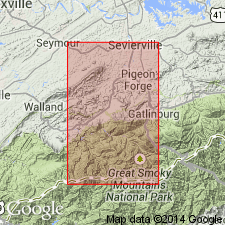
- Usage in publication:
-
- Hesse sandstone*
- Hesse quartzite member*
- Modifications:
-
- Age modified
- AAPG geologic province:
-
- Appalachian basin
Summary:
On Chilhowee Mountain, used as Hesse sandstone of Chilhowee group. In the rest of northeastern TN, used as Hesse quartzite member of Erwin formation of Chilhowee group. Age changed to Cambrian based on rediscovery of fossils in underlying Murray shale by R.A. Laurence in 1962.
Source: GNU records (USGS DDS-6; Reston GNULEX).
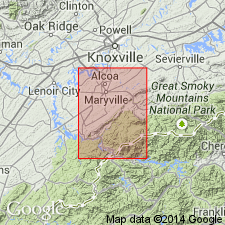
- Usage in publication:
-
- Hesse Quartzite*
- Modifications:
-
- Age modified
- AAPG geologic province:
-
- Appalachian basin
Summary:
Hesse Quartzite was named by Keith (1895) as Hesse Sandstone, probably for Hesse Creek, a southern tributary of Little River, although this was not specifically stated. He mentioned occurrence of Hesse in "high table-land known as the 'Flats'" which is drained by Flat Creek; this can be appropriately designated as type locality. Top part of Keith's Hesse is now Helenmode Formation, but the rest is mapped here much as it was in Knoxville and Loudon folios of Keith (1895 and 1896, respectively). Age is Cambrian based on discovery of Lower Cambrian fossils in Murray Shale below.
Source: GNU records (USGS DDS-6; Reston GNULEX).
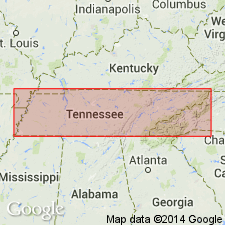
- Usage in publication:
-
- Hesse Sandstone
- Modifications:
-
- Mapped
- AAPG geologic province:
-
- Appalachian basin
Summary:
Cambrian Hesse Sandstone of Chilhowee Group mapped in eastern TN. Consists of white, medium- to coarse-grained, vitreous quartzite. Occurs as massive ledges. Includes Helenmode Member at top, described as gray to greenish sandstone and shale. Total thickness is 600 ft.
Source: GNU records (USGS DDS-6; Reston GNULEX).
For more information, please contact Nancy Stamm, Geologic Names Committee Secretary.
Asterisk (*) indicates published by U.S. Geological Survey authors.
"No current usage" (†) implies that a name has been abandoned or has fallen into disuse. Former usage and, if known, replacement name given in parentheses ( ).
Slash (/) indicates name conflicts with nomenclatural guidelines (CSN, 1933; ACSN, 1961, 1970; NACSN, 1983, 2005, 2021). May be explained within brackets ([ ]).

